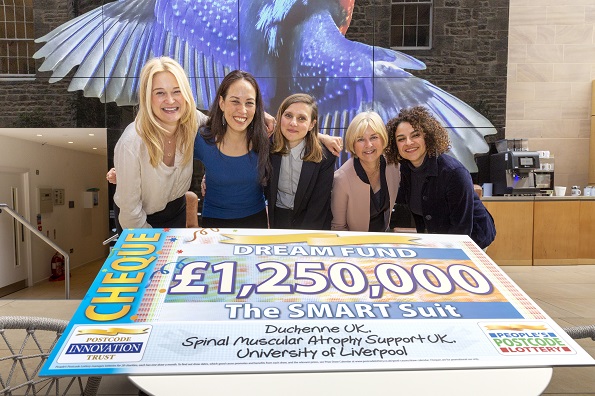
Researchers from the Inclusionaries Lab at the University of Liverpool, along with Duchenne UK and Spinal Muscular Atrophy UK (SMA UK), have received a £1.25million grant from the People’s Postcode Lottery Dream Fund to design a transformative assistive device to support and enhance upper body movement in children and young people living with progressive neuromuscular diseases.
The ‘SMART Suit’ – a first-of-its-kind exoskeleton suit to help disabled teenagers and young people use their arms and upper body – is an ambitious and highly innovative assistive technology design project with the potential to improve quality of life for a wide range of people living with neuromuscular diseases and disabilities. It aims to give people living with Duchenne muscular dystrophy (DMD), a progressive muscle-wasting disease that typically affects young boys, and other progressive diseases, back their strength, independence and dignity.
‘This is a unique and timely opportunity to address a long-term “wicked problem” in the design and commercialisation of impactful and desirable solutions for important parts of our society currently disserved by innovation,’ said Farnaz Nickpour, director of the Inclusionaries Lab. ‘Good design is people-centred and technology-enabled, improves quality of life and actively contributes to a more fair and equitable society. Through our innovative collaboration with Duchenne UK and SMA UK charities, we want to ensure advanced inclusive and human-centred design principles are embedded in the SMART Suit and, moreover, make our interdisciplinary approach and processes in this project, accessible and applicable in many other areas similarly in need of better more systemic solutions.’
The initial prototype of the suit was developed by Solid Biosciences. Duchenne UK will take on its further development and work on a strategy to bring it to market.
‘For people living with progressive conditions such as DMD and SMA, losing upper-body function means losing the ability to feed yourself, put your hand up in class, or hug your loved ones,’ said Emily Reuben, CEO of Duchenne UK. ‘Despite incredible technological progress elsewhere, this is a problem that has gone without true innovation in the past 30 years. Because of this, people living with upper-limb disability face barriers in work, education and their social lives. With the help of this grant, we can finally change this.’
‘Our dream is to create a “wearable suit”, light enough to be worn under clothes, that will replace lost upper-body strength,’ said Angela Smith-Morgan, CEO of SMA UK. ‘This really will be life changing for people living with SMA and other conditions.’
The Inclusionaries Lab is part of the University of Liverpool’s School of Engineering. An advanced design research centre for inclusive and human-centred design, it partners with clinical and academic institutions, industry and public and third-sector groups, providing expertise in design research and innovation across the mobility and healthcare sectors. The lab leads strategic design research in four areas: inclusive mobility, healthcare innovation, psychosocial inclusion and design for end-of-life.


